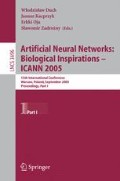Abstract
The temporal dimension is very important to be considered in many cognitive tasks involving a decision making or a behavior in response to spatio-temporal stimuli, such as vision, speech and signal processing. Thus, the capacity of encoding, recognizing, and recalling spatio-temporal patterns is one of the most crucial features of any intelligent system either artificial or biologic. If some connexionnist or hybrid model integrates the temporal data as spatial input, few other models take them into account together internally either in training or in architecture. Temporal Organization Map TOM is one of the latest types. In this paper, we propose a model gathering saptio-temporal data coding, representation and processing based on TOM map, and yielding to a Spatio-Temporel Organization Map (STOM). For spatio-temporal data coding, we use the domain of complex numbers to represent the two dimensions together. STOM architecture is the same as TOM, however, training is ensured by the spatio-temporal Kohonen algorithm to make it able to manage complex input.
Access this chapter
Tax calculation will be finalised at checkout
Purchases are for personal use only
Preview
Unable to display preview. Download preview PDF.
References
Alexandre, F.: A functional design of cortex: the cortical column visual and motor aspects. PhD thesis. University of Nancy (1990)
Mountcastle, V.B.: Perceptual Neurosciences: the cerebral cortex. Havard university press, Cambridge (1998)
William, H.: Columns and modules. MIT encyclopedia of the cognetive sciences (1998)
Casti, A.R.R., Omurtag, A., Sornborger, A., aplan, E., Knight, B., Victor, J., Sirovich, L.: A population study of integrate and fire or burst neuron. Neural Computation 14(5) (May 2002)
Durand, S.: Learning speech as acoustic sequences with the unsupervised model TOM. In: NEURAP, 8th inter conf on neural networks and their applications, Marseille france (1995)
Haffner, P., Waibel, A.: A Multi-State time delay neural networks for continuous speech recognition. In: Adv. in neural information prong system 4, San Mateo, CA, pp. 135–143 (1992)
Gestner, W., Kistler, W.: Spiking neuron models. Cambridge university Press, Cambridge (2002)
Wiemer, J.C.: The Time-Organized Map (TOM) algorithm: extending the self-organizing map (SOM) to spatiotemporal signals. Neural Computing 15 (May 2003)
Fitch, R., Miller, S., Tallal, P.: Neurobiology of speech perception. Annual review of neuroscience 20, 331–353 (1997)
Aitkin, L.: The auditory cortex, structural and functional bases of auditory perception. Chapman and Hall, Boca Raton (1990)
Vaucher, G.: A la recherche d’une algerbre neuronale spatio-temporal. Ph.D. Supelec, Renne University (1996)
Ashouri, M.R.: Isolated word recognition using a high-order statistic and time delay neural network. In: Proc of the 1997 IEEE Signal Processing Workshop on H-O-Ss (July 1997)
Mozayyani, N., Alanou, V., Derfus, J.F., Vaucher, G.: A spatio-temporal data coding applied to kohonen maps. In: Inter. conf. on Artificial Neural Natwork, October 1995, vol. 2, pp. 75–79 (1995)
Mozayyan, N.: Introduction au codage spatio-temporel dans les architectures classiques des réseaux de neurones artificiels. PhD, Suplec, campus universitaire de rennes, juillet (1998)
Baig, A.R.: Une approche méthodologique de l’utilisation des STAN applique a la reconnaissance visuelle de la parole. PhD, Suplec, campus universitaire de rennes, avril (2000)
Dorrizzi, B., Duval, J.M., Hebar., H.: Utilisation des réseaux récurrent pour la prévision de la consommation électrique. In: Proc. Neural Networks and their application, France (1992)
Vaucher, G.: A Complex-Valued spiking machine. In: Kaynak, O., Alpaydın, E., Oja, E., Xu, L. (eds.) ICANN 2003 and ICONIP 2003, vol. 2714, pp. 967–976. Springer, Heidelberg (2003)
Thorpe, S.: Spiking arrival times: Ahighly efficient coding scheme for neural networks. In: Parallel Processing in Neural System, Elsevier Press, Amsterdam (1990)
Zhang, Y.: Speaker independent isolated word, Technical report, university of western, Australia (January 2002)
Calliope. La parole et son traitement automatique. Masson, Paris, Milan, Barcelone (1989)
Kanzing, J.: Time delayed self-organizing maps. IJCNN, 331–336 (1990)
Chappell, G., Taylor, M.: The Temporal Kohonen Map. Neural Networks 6, 441–455
Koskela., T., Vastra., M., Heikkonon., J., Kaski., K.: Time series prediction using recurrent SOM with local linear models. Int. Journal on knowledge-based Intelligent Engineering System 6, 60–68
Author information
Authors and Affiliations
Editor information
Editors and Affiliations
Rights and permissions
Copyright information
© 2005 Springer-Verlag Berlin Heidelberg
About this paper
Cite this paper
Salem, Z.N.B., Mouria-beji, F., Kamoun, F. (2005). Spatio-Temporal Organization Map: A Speech Recognition Application. In: Duch, W., Kacprzyk, J., Oja, E., Zadrożny, S. (eds) Artificial Neural Networks: Biological Inspirations – ICANN 2005. ICANN 2005. Lecture Notes in Computer Science, vol 3696. Springer, Berlin, Heidelberg. https://doi.org/10.1007/11550822_58
Download citation
DOI: https://doi.org/10.1007/11550822_58
Publisher Name: Springer, Berlin, Heidelberg
Print ISBN: 978-3-540-28752-0
Online ISBN: 978-3-540-28754-4
eBook Packages: Computer ScienceComputer Science (R0)

